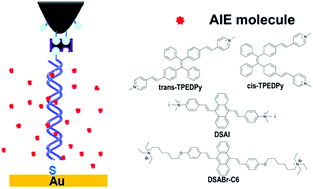Investigation of the binding modes between AIE-active molecules and dsDNA by single molecule force spectroscopy†
Abstract
AIE (aggregation-induced emission)-active molecules hold promise for the labeling of biomolecules as well as living cells. The study of the binding modes of such molecules to biomolecules, such as nucleic acids and proteins, will shed light on a deeper understanding of the mechanisms of molecular interactions and eventually facilitate the design/preparation of new AIE-active bioprobes. Herein, we studied the binding modes of double-stranded DNA (dsDNA) with two types of synthetic AIE-active molecules, namely, tetraphenylethene-derived dicationic compounds (cis-TPEDPy and trans-TPEDPy) and anthracene-derived dicationic compounds (DSAI and DSABr-C6) using single molecule force spectroscopy (SMFS) and circular dichroism (CD) spectroscopy. The experimental data indicate that DSAI can strongly intercalate into DNA base pairs, while DSABr-C6 is unable to intercalate into DNA due to the steric hindrance of the alkyl side chains. Cis-TPEDPy and trans-TPEDPy can also intercalate into DNA base pairs, but the binding shows strong ionic strength dependence. Multiple binding modes of TPEDPy with dsDNA have been discussed. In addition, the electrostatic interaction enhanced intercalation of cis-TPEDPy with dsDNA has also been revealed.


 Please wait while we load your content...
Please wait while we load your content...